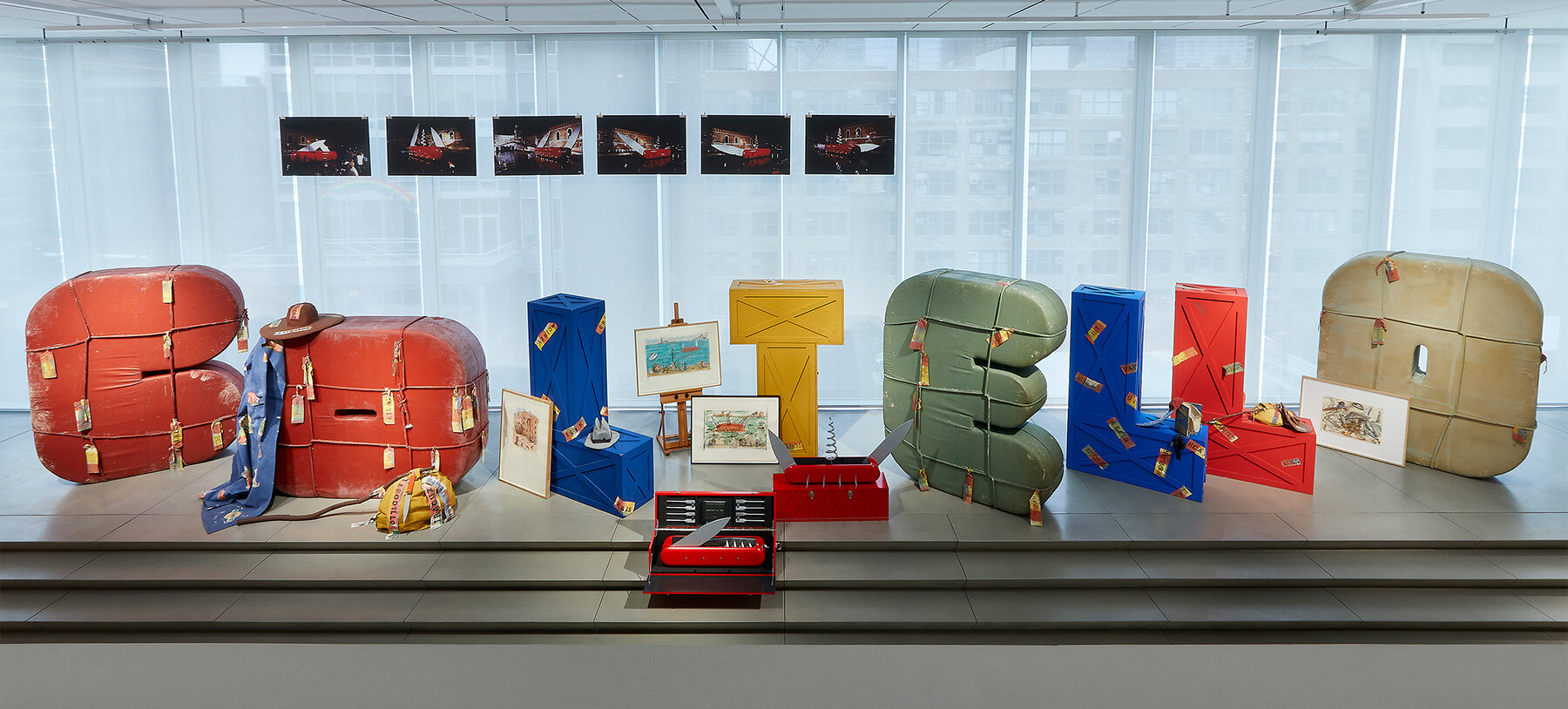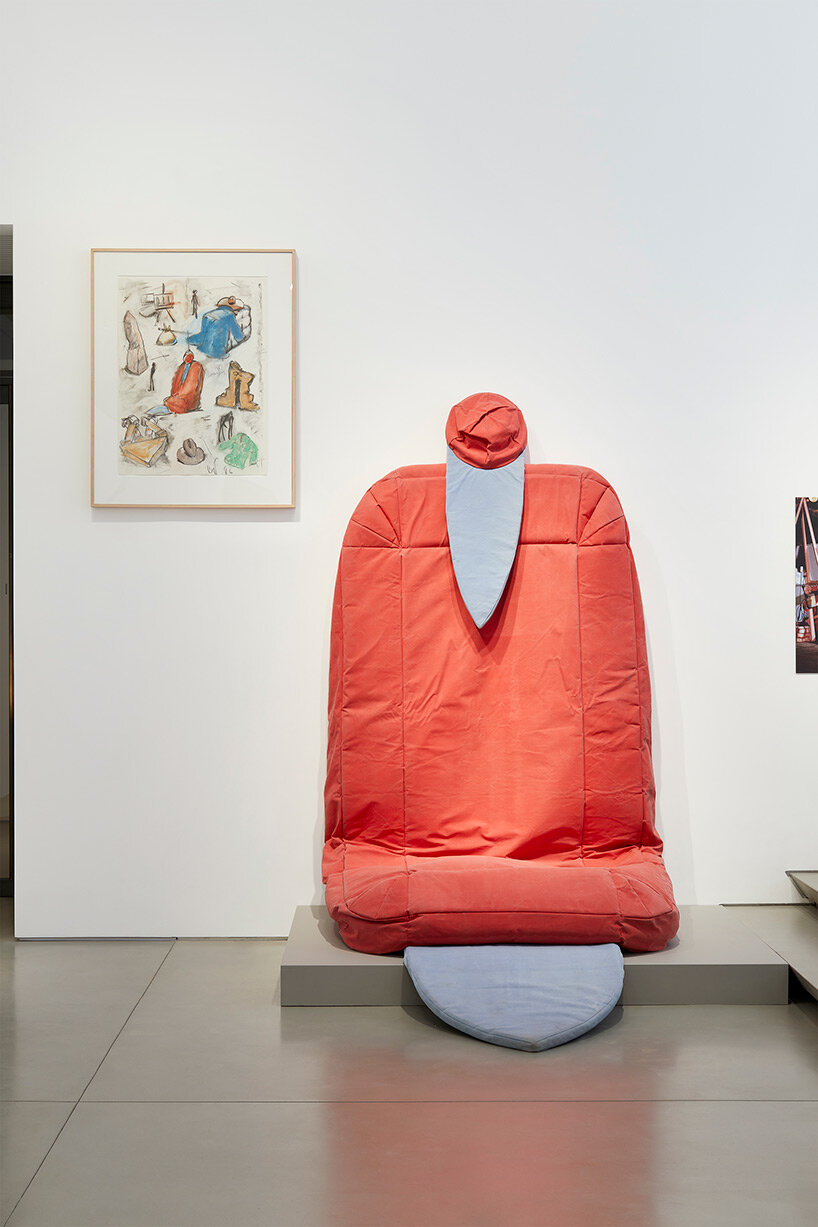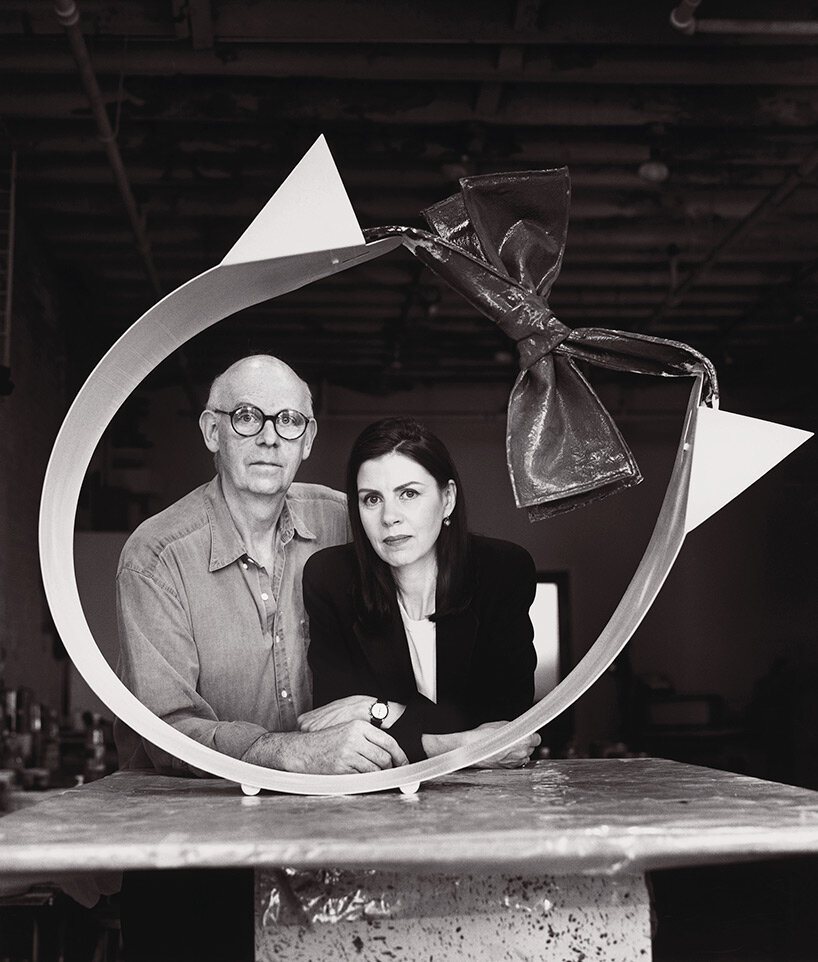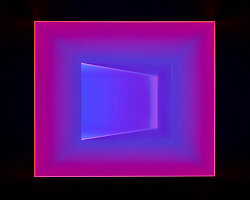from now through may 9, 2021, pace gallery celebrates one of the 20th century’s most influential artistic duos — claes oldenburg and the late coosje van bruggen — and the collaborative spirit of their artistic achievements and romantic partnership over the course of three decades. together, oldenburg and van bruggen created some of the most recognizable landmarks in urban and public spaces, which remain beloved across the world to this day.
occupying two major galleries at pace’s 540 west 25th street location in new york, ‘a duet’ brings together key milestones in their collaboration — from their important early works in the 1980s, to their final ones together in the late 2000s — through seminal works in sculpture, models, and drawings. the show is anchored by dropped bouquet (2021), the realization of the duo’s final sculptural collaboration before van bruggen’s death in 2009, which has been produced at monumental scale for the first time. the celebratory and poignant work depicts a garland of faux wildflowers tumbling to the ground and fixed at the moment of impact as if in suspended animation.
on the occasion of the exhibition, designboom spoke with oliver shultz, curatorial director at pace gallery, about how ‘a duet’ sheds new light on the philosophical, aesthetic, and artistic dialogue between these two artists.

oldenburg/van bruggen dropped bouquet, 2021
painted aluminum | 12′ 3″ × 9′ 3″ × 14′ 10″ (373.4 cm × 281.9 cm × 452.1 cm)
© 2021 claes oldenburg and coosje van bruggen, photography by tom powel imaging
with ‘claes & coosje: a duet’, pace gallery places a particular emphasis on van bruggen’s vital yet underrecognized role in their collective practice. oldenburg and van bruggen met in 1971, when van bruggen was a curator at amsterdam’s stedelijk museum, and they married six years later. in the 1980s, van bruggen transformed into full-fledged artistic collaborator, and an artist in her own right. the duo’s important early collaborations from the 1980s — including models for spitzhacke and the entropic library — are presented in dialogue with sculptures and models from the 90s and 2000s, including selections from the celebrated suite of musical instruments created around the time of their last major solo show, the music room.
the exhibition also features a selection of sculptural works from some of the artists’ best-known collaborations, including original artifacts, drawings, and soft sculptures from the duo’s site-specific performance project for venice, italy, il corso del coltello (the course of the knife). commissioned, conceived, and realized with writer germano celant and architect frank gehry, the event involved the creation and embarkation of a sea-worthy sculpture in the shape of a giant swiss army knife, with oars protruding from its red-enameled hull.
read on for our interview with oliver shultz for further insight into one of the most fruitful, impactful, and sometimes controversial collaborations in 20th century art.

oldenburg/van bruggen dropped bouquet, 2021
painted aluminum | 12′ 3″ × 9′ 3″ × 14′ 10″ (373.4 cm × 281.9 cm × 452.1 cm)
© 2021 claes oldenburg and coosje van bruggen, photography by tom powel imaging
designboom (DB): what was the criteria in selecting the works for the show?
oliver shultz (OS): the occasion for the show was the debut of oldenburg and van bruggen’s dropped bouquet (2021). because it is the final monumental work that they conceived together before van bruggen’s death in 2009, we knew that this would be a very special moment. it seemed like the right time to revisit the story of their remarkable relationship with the nuance and care it deserves. of course the exhibition could have just been dropped bouquet and some closely related drawings and models, but the more we thought about it, the more we felt that the motif of the fallen bouquet of canvas wildflowers had special significance: it stands in for their relationship as a whole. that’s why we wanted to create an exhibition that was more generous in terms of spanning the arc of their entire shared history and bringing together key works that are milestones in their collaboration.
despite how canonical many of their well-known large-scale projects have been, the whole history of oldenburg and van bruggen’s relationship and how it fed into their artistic collaboration is still not widely known. the myth of the individual male genius is so strong, and oldenburg is such a major name, I think it has historically tended to overshadow van bruggen’s vital and coequal role in their collaborative practice.

oldenburg/van bruggen dropped bouquet, 2021
painted aluminum | 12′ 3″ × 9′ 3″ × 14′ 10″ (373.4 cm × 281.9 cm × 452.1 cm)
© 2021 claes oldenburg and coosje van bruggen, photography by tom powel imaging
OS (continued): when arne, maartje, and I began talking about how to present dropped bouquet, we all agreed this would be a fantastic opportunity to put some pressure on this received narrative, and to delve more deeply and more thoughtfully into the nuances of coosje’s contributions. we did this by highlighting works that exemplify key aspects of her co-authorship and her influence on their mode of collaboration. for example, starting with spitzhacke (1982), the earliest sculpture in the show, was a way of marking the fact that she was a curator at documenta 7 at the time the piece was shown, which is a way of marking the complexity of their professional relationship at the outset. by the late 1980s, they have become collaborators through and through, and it’s thrilling to present the rather large model for the masterful installation the entropic library (1989), as it was very much a work that coosje conceived in response to an invitation to show in the legendary group show magiciens de la terre at the pompidou. she worked with claes to realize the idea in sculptural form. coosje was such a literary person, and there, language literally takes shape as sculpture; and I think it very much informed their incredible torn notebook works, several of which we’ve included in the show.

installation view of claes & coosje: a duet, 540 west 25th street, new york | march 26 – may 9, 2021
photography courtesy of pace gallery
OS (continued): in a few instances, as with typewriter eraser (1994), the show highlights forms that come from claes’s early works of the 1960s. as an art historian, no one was more of an expert in claes’s work than coosje, and together they mined his early archive and translated unrealized ideas into large-scale sculpture (in this case for the NGA). however most of the works in the show reflect forms that they developed together, and were the result of an extensive intellectual and artistic exchange, a kind of contrapuntal relationship that arne calls ‘a duet.’
everything in the show flows from that idea in some way, which is partly why we wanted to also feature one of the last bodies of sculptural works exhibited together at pace before coosje’s death, which are the soft instruments from the music room and also the monumental and amazing leaning clarinet (2006). on the seventh floor, we highlighted works from il corso del coltello (1985), their site-specific performance project for venice realized with frank gehry, germano celant, and pontus hulten. that gets a lot of real estate because of how seminal it was for their way of collaborating going forward. all of these things together help narrate this incredibly story, of which dropped bouquet embodies the final chapter, and in that sense is really a celebration of their incredibly fruitful exchange.

installation view of claes & coosje: a duet, 540 west 25th street, new york | march 26 – may 9, 2021
photography courtesy of pace gallery
DB: how does the exhibition highlight coosje van bruggen’s often under-recognized role in the duo’s collective practice?
OS: in addition to all the ways described above, we have tried to center the body of work that claes and coosje produced together as the result of a collective practice. if you understand claes and coosje as an artistic collective, it goes some way toward unpacking the nature of her role in conceiving and realizing these works. it also sheds light on her continued emphasis and practice as a curator a writer, and how this is in no way opposed to her work together with claes as an artist.
the show tries to suggest that as a collective practice, oldenurg/van bruggen was actually way ahead of its time. the idea that curatorial work and research-based practice are coterminous and often overlapping with contemporary artistic practice has become second nature to artists of younger generations, but it has a fraught history in the reception of postwar art. that sense of coosje being a curator-as-artist is partially what marks her as way ahead of her time. the exhibition highlights instances where her scholarly, literary, writerly, and, indeed, curatorial sensibilities shaped the work she made with claes, and which create beautiful and dynamic counterpoints to claes’s sculptural imagination.

installation view of claes & coosje: a duet, 540 west 25th street, new york | march 26 – may 9, 2021
photography courtesy of pace gallery
DB: in developing the exhibition, what did you learn about claes oldenburg and coosje van bruggen’s relationship and artistic dialogue that you might not have previously known? did anything surprise you?
OS: I had always thought of coosje as a very serious intellectual and scholar who brought a critical rigor and philosophical acumen to claes’s more chaotic and dionysian way of being; however in learning more about coosje, I learned how important humor, wit, and indeed, pleasure were for her. she was an incredibly warm and funny person. both of them had that in common. I would say I was also deeply moved by how powerful her effect as a curator was on the other artists in whom she was interested, especially early in her career before she and claes were married. she was an expert on american artists of the 1960s and ‘70s, especially minimalists and conceptual artists, and everyone I spoke to from that generation said fascinating things about how meaningful they had found her engagement with their work.

installation view of claes & coosje: a duet, 540 west 25th street, new york | march 26 – may 9, 2021
photography courtesy of pace gallery
DB: what do you hope visitors come away with? what new perspectives can be uncovered about their collaborative practice?
OS: first and foremost, I hope visitors come away with a sense of the joy and vitality, the wit and also the unparalleled inventiveness of oldenburg and van bruggen’s sculptures. but I also hope visitors have a sense of how complex and nuanced their relationship was, and how profoundly coosje contributed to their collaborations, and to the complexity and multilayered nature of how they signified. dropped bouquet is not just a celebratory gesture; it could be a wedding bouquet that’s fallen to the ground, but it could also be flowers on a grave. that duality between life and death, celebration and mourning, the pull of gravity and the grace of suspension, this was always held in tension by oldenburg and van bruggen’s work.

installation view of claes & coosje: a duet, 540 west 25th street, new york | march 26 – may 9, 2021
photography courtesy of pace gallery
OS (continued): I hope visitors have a sense of how crucial van bruggen’s role was in making that the case. I also hope we can show a little bit of their intimacy and sweetness between each other, and how that was inextricable from the sculpture itself. that is what we try to do in our library presentation in the form of gifts and valentines that claes made for coosje. more than a decade after her death, I think it’s the right time to give her the credit she deserves for the remarkable work that she and claes made together.

DB: what do you think makes the large-scale projects of claes oldenburg and coosje van bruggen so significant and beloved to this day?
OS: I think it has to do with the fact that they are monumental forms yet they are monuments to nothing in particular – if anything they are monuments to everydayness—and to art itself. it has to do with the fact that they are not depicting real things in the world, but rather depicting their own status as sculptures, while responding very directly to the specificity of the conditions of place, culture, and the history into which their work intervenes.

installation view of claes & coosje: a duet, 540 west 25th street, new york | march 26 – may 9, 2021
photography courtesy of pace gallery
OS (continued): I think it is the immediacy and accessibility of their large-scale works, their strangeness and whimsy, but also the way they function as icons of place. spoonbridge and cherry is not just a famous sculpture; it is a symbol of the walker art center and minneapolis. the same could be said of the shuttlecocks at the nelson-atkins, and on and on. in many cases the work draws us toward it and it becomes a site of play and joyous exchange, especially for kids. it’s a common site to see kids climbing through the holes in the button in philadelphia or sliding down the matchstick in barcelona — or families picnicking around the spitzhacke in kassel as if it were contemporary version of seurat’s grande jatte staged in reality. all of these things enliven the work and weave it into the landscape, and the works become wrapped up in the lives and memories of the people who grow up with them.

installation view of claes & coosje: a duet, 540 west 25th street, new york | march 26 – may 9, 2021
photography courtesy of pace gallery

installation view of claes & coosje: a duet, 540 west 25th street, new york | march 26 – may 9, 2021
photography courtesy of pace gallery

installation view of claes & coosje: a duet, 540 west 25th street, new york | march 26 – may 9, 2021
photography courtesy of pace gallery

installation view of claes & coosje: a duet, 540 west 25th street, new york | march 26 – may 9, 2021
photography courtesy of pace gallery

installation view of claes & coosje: a duet, 540 west 25th street, new york | march 26 – may 9, 2021
photography courtesy of pace gallery

installation view of claes & coosje: a duet, 540 west 25th street, new york | march 26 – may 9, 2021
photography courtesy of pace gallery

claes oldenburg and coosje van bruggen in their studio with ‘standing collar with bow tie’ (1992), 1992
photo by jesse frohman, courtesy trunk archive
exhibition information:
title: claes & coosje: a duet
gallery: pace gallery
location: 540 west 25th street, new york
dates: march 26 – may 9, 2021
happening now! in an exclusive interview with designbooom, CMP design studio reveals the backstory of woven chair griante — a collection that celebrates twenty years of Pedrali’s establishment of its wooden division.

















